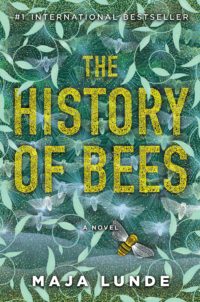Too little access to nectar, not enough for the bees
 The History of Bees
The History of Bees
by Maja Lunde
translated from Norwegian by Diane Oatley
This is a novel intertwining three stories in three time periods – past, present (ish) and future. The three narrators are linked by bees and their importance to agriculture. But they’re also great individual stories.
We open with the strangest of the three: Tao, in Sichuan in 2098. She hand pollinates flowers – painstaking, delicate, long days at work that give her only an hour each day with her three-year-old son Wei-Wen. Tao lives in an agricultural region that grows fruit, but throughout China hand-pollination is necessary to keep the increasingly slim food chain chugging along. She dearly wants her son to learn all he can so that he stands a chance of being sent away to school rather than to the fields but her husband Kuan wants to enjoy spending time with Wei-Wen, for him to be happy.
“I stretched as far as I could, but couldn’t quite reach the blossom at the very top. I was about to give up, but knew I might be punished, so I tried once more. Our pay was docked if we used up the pollen too quickly. And our pay was docked if we used too little. The work was invisible. When at the end of the day we climbed down from the trees, there was no evidence of our work except for the red chalk Xs on the tree trunks…It wasn’t until autumn came and the trees were laden with fruit that we would know who among us had actually succeeded in their work.”
In 2007, George is a bee farmer in Ohio. He loves his bees and tries to keep his farm traditional, unlike the neighbouring bee farmer who has modernised and makes a lot more profit. All he wants is for his son Tom to join him in the business once he’s done with university, but Tom shows no interest and really only comes home to visit his mother, Emma. Emma wants George to sell the farm so that they can retire to Florida as some of their friends have done, but George can’t imagine ever leaving his farm.
“We had 324 hives. 324 queens, each with her own colony, located throughout the area in different places, rarely more than 20 in each place. If we’d lived in another state, we could have had up to 70 hives in one site. I knew a beekeeper in Montana, he had gathered close to 100 in the same place. The region was so fertile that the bees only had to fly a few yards to find everything they needed. But here, in Ohio, the agriculture wasn’t diversified enough. Mile after mile of corn and soybeans. Too little access to nectar, not enough for the bees to live on.”
William in Hertfordshire, England, in 1851 is a seed merchant who has taken to his bed in a depression brought on by the realisation that he has failed to live the life he had intended. He was a student of science, a promising entomologist. But marriage and a string of children led him to need money and his books lie under a pile of dust in his study. Until a conversation with his wayward son reminds him that he used to be fascinated by bees and would love to develop a beehive that allows him to observe them.
“The worn-out state of her wings, yes, her death in its entirety, is a clear sign that she has done what she was put on earth to do, accomplished an infinite amount, taking into consideration her tiny body.
I would never have such a death. There were no clear signs that I’d done what I was put on earth to do. I had not accomplished anything at all. I would grow old, my body would swell, and subsequently fade away, without any trace of me left behind. Nothing would remain.”
Through these three stories we learn a lot about bees and pollination. But they are linked in other ways too. All three narrators have one son who is in some way a source of pain. They are all emotionally distant from their spouse and don’t really talk to them about the important things in life. The stories are all touching and go in different directions.
But you can’t avoid the fact that this novel is a heartfelt warning about the dying-off of bees and their importance to humanity and, well, it’s a little didactic about the death of bees – and I say that as someone who deeply cares. If you don’t mind a novel with an obvious message, then this is a good read with a very interesting and original dystopia in the future sections.
Bienes historie published 2015 by Aschehoug.
This translation published August 2017 by Touchstone.
Source: an electronic copy was supplied free by the publisher via NetGalley.